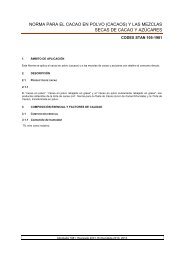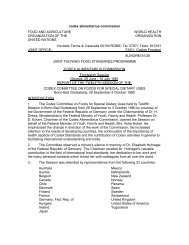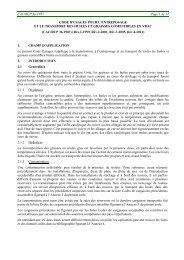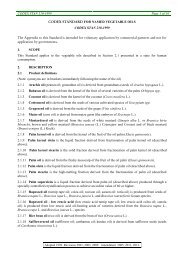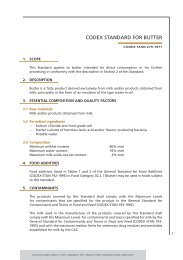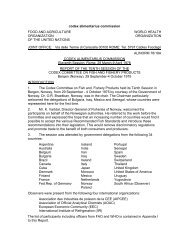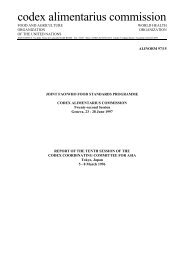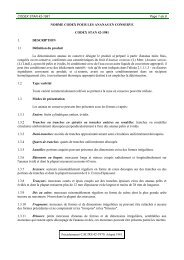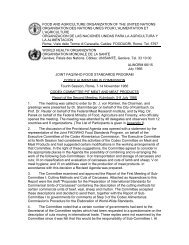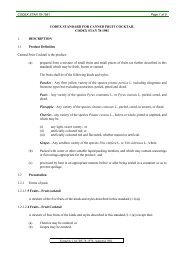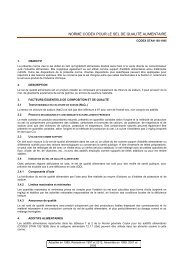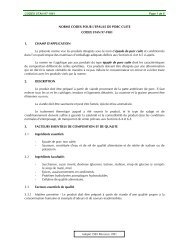REP13/FH JOINT FAO/WHO FOOD STANDARDS PROGRAMME ...
REP13/FH JOINT FAO/WHO FOOD STANDARDS PROGRAMME ...
REP13/FH JOINT FAO/WHO FOOD STANDARDS PROGRAMME ...
Create successful ePaper yourself
Turn your PDF publications into a flip-book with our unique Google optimized e-Paper software.
<strong>REP13</strong>/<strong>FH</strong> 9<br />
Provisions on protection of source plants, irrigations systems and access to visitors<br />
77. On the need to include provisions for the protection of source plants (section 3.1.2) and<br />
recommendations to avoid sprinkler irrigation systems and flood irrigation (section 3.2.1.1), the Committee<br />
noted that there were varying views. The Committee therefore recommended these provisions receive<br />
further consideration in the development of the Code.<br />
78. In the case of section 3.2.3, paragraph 25, relating to provisions to deter entry of casual visitors and, to<br />
the extent possible, children, a delegation proposed its deletion noting that the source plant would be dried<br />
later in the process and that the risks posed by casual visitors and children were not the same as for fresh<br />
leafy greens or melons. However, the Committee agreed to its retention.<br />
Microbiological specifications<br />
79. The Committee agreed that section 5.2.3, paragraph 71 should be redrafted to provide guidance more<br />
appropriate for a code of practice; that paragraph 73 should be retained, but that the reference in<br />
paragraph 74 to a microbiological criterion for Salmonella should be deleted or retained in square brackets<br />
until a decision was taken on the appropriateness of a criterion for Salmonella.<br />
80. In order to take a decision on a criterion for Salmonella, the Committee agreed to request that <strong>FAO</strong><br />
and <strong>WHO</strong> undertake a risk assessment to determine whether there is a significant public health risk from<br />
Salmonella associated with consumption of spices and dried aromatic herbs and to evaluate whether criteria<br />
for Salmonella are meaningful to ensure adequate consumer health protection.<br />
81. It was further proposed that <strong>FAO</strong> and <strong>WHO</strong> extend their call for data to any microbiological hazard<br />
associated with spices and dried aromatic herbs in order to identify any other foodborne pathogens of<br />
concern.<br />
82. It was also agreed that <strong>FAO</strong> and <strong>WHO</strong> should identify the range of spices to be covered in the Code,<br />
and the critical points for control of Salmonella and/or other foodborne pathogens.<br />
83. Specific questions that <strong>FAO</strong> and <strong>WHO</strong> could address include:<br />
Is there a significant risk associated with Salmonella or other identified foodborne pathogens in<br />
spices and dried aromatic herbs? If so, are there particular spices and dried aromatic herbs<br />
which present a greater risk than others?<br />
Is the criterion and the associated sampling plan for Salmonella in the draft Annex<br />
(CX/<strong>FH</strong> 12/44/8) meaningful for public health protection?, i.e. what is the performance of the<br />
existing microbiological criterion and associated sampling plan given the information on the<br />
prevalence and concentration of Salmonella in spices and dried aromatic herbs and identify and<br />
consider alternative microbiological criteria and associated sampling plans that could be<br />
effectively applied to the management of Salmonella (or any other identified pathogen) in spices<br />
and dried aromatic herbs given the available information on prevalence and levels of<br />
contamination.<br />
What would be the impact on public health of microbial reduction treatments of different levels,<br />
e.g., 2 – 5 log reduction of Salmonella provided to spices and dried aromatic herbs?<br />
Conclusion<br />
84. The Committee agreed to establish an electronic working group led by the United States of America,<br />
working in English only, to redraft the Code taking into account the decisions taken at the Session, and the<br />
written comments submitted. The Committee noted the provisional offer of the Delegation of India to cochair<br />
the electronic working group, pending confirmation of their government.<br />
Status of the Proposed Draft Code of Hygienic Practice for Spices and Dried Aromatic Herbs<br />
85. The Committee agreed to return the proposed draft renamed Code to Step 2 for redrafting by the<br />
electronic working group, circulation for comments at Step 3 and consideration by the next Session of the<br />
Committee.



